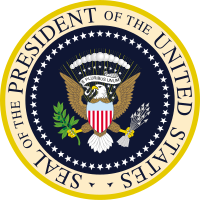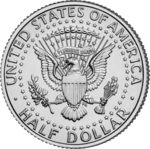Seal of the president of the United States

The Seal of the President of the United States is the official arms of the U.S. presidency and is based on the Great Seal of the United States.
The first U.S. president to use a seal distinctly for the presidency was Rutherford B. Hayes who authorized its creation in 1880. Hayes used the seal for White House invitations and on the president's standard (flag) on a field of blue with four gold stars in the corners. Woodrow Wilson was the first president to apply the presidential seal to a state china service instead of using the great seal. Harry S. Truman had the seal redesigned on October 26, 1945, adding the circle of stars and re-orienting the eagle towards its own right, making the seal consistent with long-established heraldic custom. The fact that it was now facing the olive branch, thus symbolizing that the United States favors peace, was given as an explanation for the change.[1]
Symbolism
Symbolism in the Seal of the President of the United States is similar to that in the Great Seal of the United States:
- The bird holds in its beak a banner flying above its head with the Latin phrase "E pluribus unum" which translates to English as "out of many, one." The meaning of this motto is multi-fold: suggesting that out of many colonies or states emerge a single nation; out of many peoples, races and ancestry of nationalities have emerged a single people and nation.
- Above the banner an arced cornea of thirteen stars representing the original states are arranged; and above the stars thirteen clouds.
- In the eagle's right talon, it clutches an olive branch with thirteen leaves signifying peace.
- In the eagle's left talon it clutches a bundle of thirteen arrows symbolizing military might.
- The 50 stars in the outer circle represents the number of U.S. states.
Official use
The seal is most often seen:
- on the lectern at presidential press conferences (the words "SEAL OF THE PRESIDENT OF THE UNITED STATES" sometimes encircle the "eagle-within-stars" design)
- on White House documents, however the words "SEAL OF THE PRESIDENT OF THE UNITED STATES" are not used
- on the sides of presidential transports Air Force One, Marine One, and the presidential limousine.
- at the center of the iconic oval rug in the Oval Office of the White House, however the words "SEAL OF THE PRESIDENT OF THE UNITED STATES" are not used
- at the center of the ceiling in the Oval Office of the White House
- affixed to the balcony of the South Portico during a State Arrival Ceremony
- on the presidential flag, however the words "SEAL OF THE PRESIDENT OF THE UNITED STATES" are not used
- etched in gold onto presidential china, such as the Wilson or Reagan china, which is often used at state dinners at the White House
- on the reverse of the Kennedy half dollar coin, however the words "SEAL OF THE PRESIDENT <sĆ ć É é Í í Ĺ ĺ Ń ń Ó ó Ŕ ŕ Ś ś Ú ú Ý ý Ź ź À à È è Ì ì Ò ò Ù ù Â â Ĉ ĉ Ê ê Ĝ ĝ Ĥ ĥ Î î Ĵ ĵ Ô ô Ŝ ŝ Û û Ŵ ŵ Ŷ ŷ Ä ä Ë ë Ï ï Ö ö Ü ü Ÿ ÿ ß Ã ã Ẽ ẽ Ĩ ĩ Ñ ñ Õ õ Ũ ũ Ỹ ỹ Ç ç Ģ ģ Ķ ķ Ļ ļ Ņ ņ Ŗ ŗ Ş ş Ţ ţ Đ đ mall>OF THE UNITED STATES" are not used, but rather "UNITED STATES OF AMERICA" on the top and "HALF DOLLAR" on the bottom. (For the United States Bicentennial, a depiction of Independence Hall was used of the reverse of the coin. The seal returned to the reverse starting in 1977).

Additional stars have been added to the seal as other states have joined the Union. The last additional star, the 50th, was added with the admission of Hawaii in 1959.
Unofficial use
Unofficial use of the seal is regulated by the White House Graphics and Calligraphy Office and monitored by the office of the White House Counsel. On September 28, 2005, Grant M. Dixton, associate counsel to George W. Bush, requested that the satirical newspaper The Onion remove the presidential seal from its website.[2][3] The Graphic and Calligraphy Office will approve of the seal's use in application of official gifts, an example being its application to a silver cigarette box presented as a gift to Franklin Roosevelt.
Use in popular culture
The seal is sometimes used in modified form as a marketing tool, or to make a political statement. The punk rock group the Ramones used a personal variation of the seal as their logo, replacing the arrows with a baseball bat, as well as the "Seal of the President of the United States" writing around it for the members' names. Blink-182 and other bands have also used the logo on T-shirts. Some fashion brands (mainly for teenagers) have also used the logo as an added design for accessories like bags. In addition, the animated menu sequence on all DVDs of The West Wing contains a slightly altered version of the seal. In the backing video for Skinny Puppy's "VX Gas Attack," featured on the Greater Wrong of the Right LIVE DVD, another altered version of the seal is shown (the olive and arrows replaced with bleeding gas nozzles, and the eagle replaced with a skull). It is also used by rap group The Diplomats as their trademark logo, except that the olive branch and arrows are usually replaced by two guns and the word "Diplomats" is across the center of the eagle.
Use in retail sales
The seal of the president, in modified form, has been used for some retail purposes. In general, commercial use of the seal is prohibited by Section 18 USC 713[4] of the United States Code, however the US Secret Service is authorized to use the seal in conjunction to fund raising sales for its charitable benefit fund. Currently the 1600 for Men line of toiletries bears a modified version of the seal (modified in that: the words "THE PRESIDENT OF THE UNITED STATES" instead of "SEAL OF THE PRESIDENT OF THE UNITED STATES" ring the stars, eagle, and shield; dark blue pervades as the base color throughout; and the eagle's feathers are silver) and includes items such as antibacterial wash, shaving cream, aftershave and soap.
Misconceptions
Many people erroneously believe that the seal is changed during times of war, so that the eagle faces the arrows in its left talon. This belief may have arisen because major changes to the seal have coincidentally been made before or after wars.[5] This misconception could also have arisen through the comments of Winston Churchill who, jokingly, criticized Truman's redesign of the seal stating that "Mr. President, with the greatest respect, I would prefer the American eagle's neck to be on a swivel so that it could face the olive branches or the arrows, as the occasion might demand".
References
- ^ "George Elsey's 'Unplanned Life'".
{{cite web}}: Unknown parameter|accessmonthday=ignored (help); Unknown parameter|accessyear=ignored (|access-date=suggested) (help) - ^ Seelye, Katharine Q. (24 October 2005). "Protecting the Presidential Seal. No Joke". The New York Times.
{{cite news}}: Check date values in:|date=(help) (TimesSelection subscription required) - ^ "White House to Onion: Stop using seal".
{{cite web}}: Unknown parameter|accessmonthday=ignored (help); Unknown parameter|accessyear=ignored (|access-date=suggested) (help) (Archived by Archive.org) - ^ U.S. House of Representatives, 18 USC Sec. 713. Use of likenesses of the great seal of the United States,....
- ^ Snopes.com (2006). A Turn of the Head. Retrieved May 18, 2006.
